In the third qualifying round for the UEFA Champions League, Red Star Belgrade welcomed Copenhagen in the first leg of their matchup for the playoffs. The home team came in as slight favourites since they were playing on their own turf and were the better team in a bigger part of the game.
They were overpowered throughout the 90 minutes resulting in fewer chances, Danish champions succeeded in getting a fortunate goal since they were awarded a penalty in the closing stage of the duel. This tactical analysis will show you how the Serbian team was controlling the situation on the pitch but have dropped their advantage and will go to the second leg with a difficult result.
Lineups
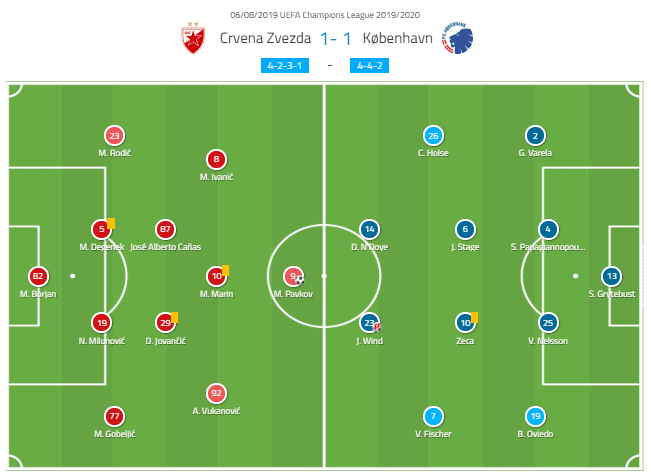
Vladan Milojević set up his tactics in their usual 4-2-3-1 formation but with a few changes in the starting eleven. The biggest surprise in the team was Aleksa Vukanović who started as a right-winger because El Fardou Ben wasn’t fit enough for 90 minutes. The second bombshell from the Serbs was Milan Pavkov in the squad instead of Richmond Boakye, which turned out to be very lucrative for them, especially due to his good communication with their star-player Marko Marin, who was once again the main attacking force of Red Star.
Stale Solbakken went into the game with a slightly changed team in comparison with their past matches. They were organised in the 4-4-2 formation with Dame N’Doye and Jonas Older Wind on top of the lineup as the key offensive players in the team. Two strikers had support from Zeca who held the midfield along with Jens Stage, and from Victor Fischer and Carlo Holse who were playing as wingers.
Crvena Zvezda’s well-organised defence
The one thing Red Star did well in their European matches since the start of the new season was the setting of their defensive structure. They kept with that routine in this game, but have raised the level of quality for one ladder, so their block seemed bulletproof in the biggest part of the first leg.
Milojević organised his players to defend in their usual 4-4-2 central block with an intention to drop lower and let the ball to the opposition. Their structure was pretty dense and centrally oriented so Copenhagen inherited the HJK’s attitude from Zvezda’s last round fixture to circle around the block.
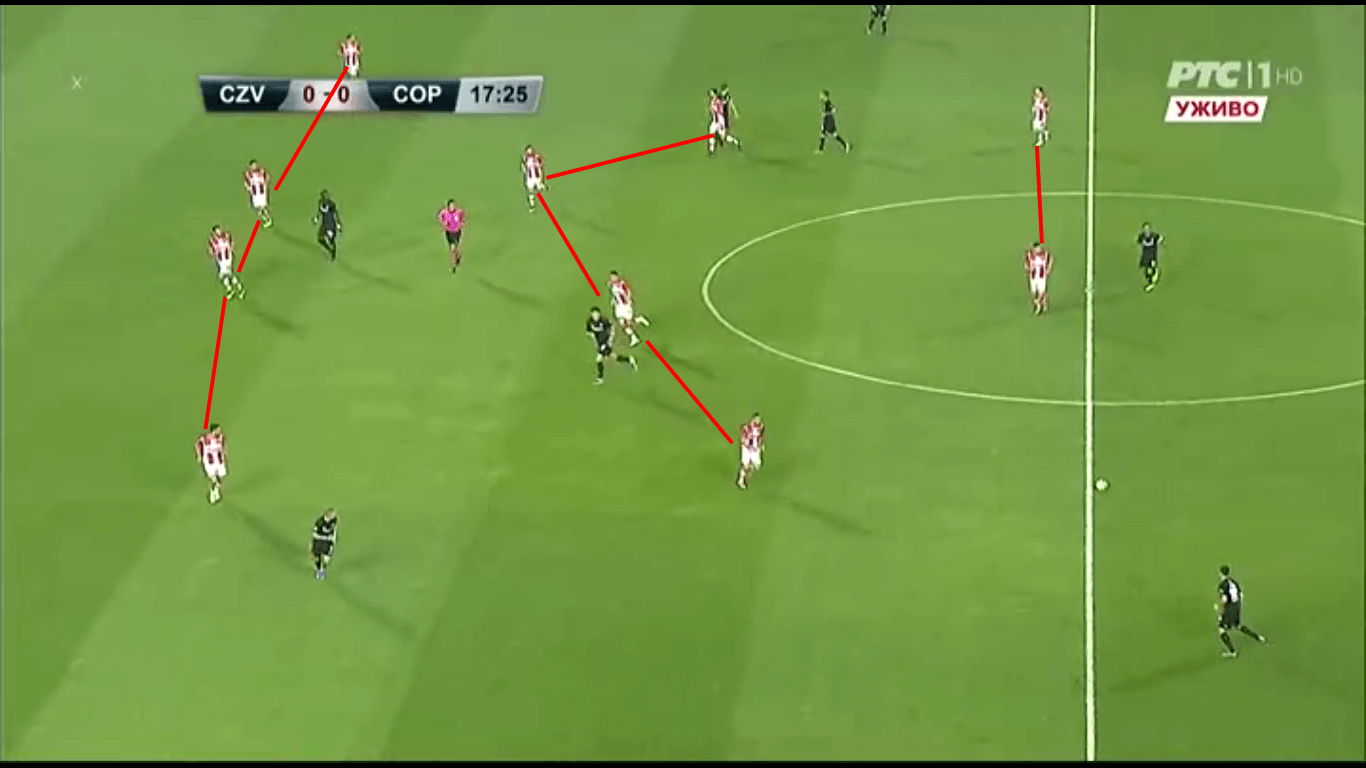
They were positioned likewise in the majority of the match but tended to go both lower in a low-block structured defence and to push higher in some sort of a counter-pressing. Danes didn’t have a solution to break through the opponent’s lines either way and struggled to create chances even though they had greater possession of the ball.
Their biggest problem was that their key attacking players were lost in the density of Red Star’s setup. They were guarded pretty well and didn’t have a lot of space to get the ball or to manoeuvre with it when they received a pass, especially when it came to playing against the weaker sides.
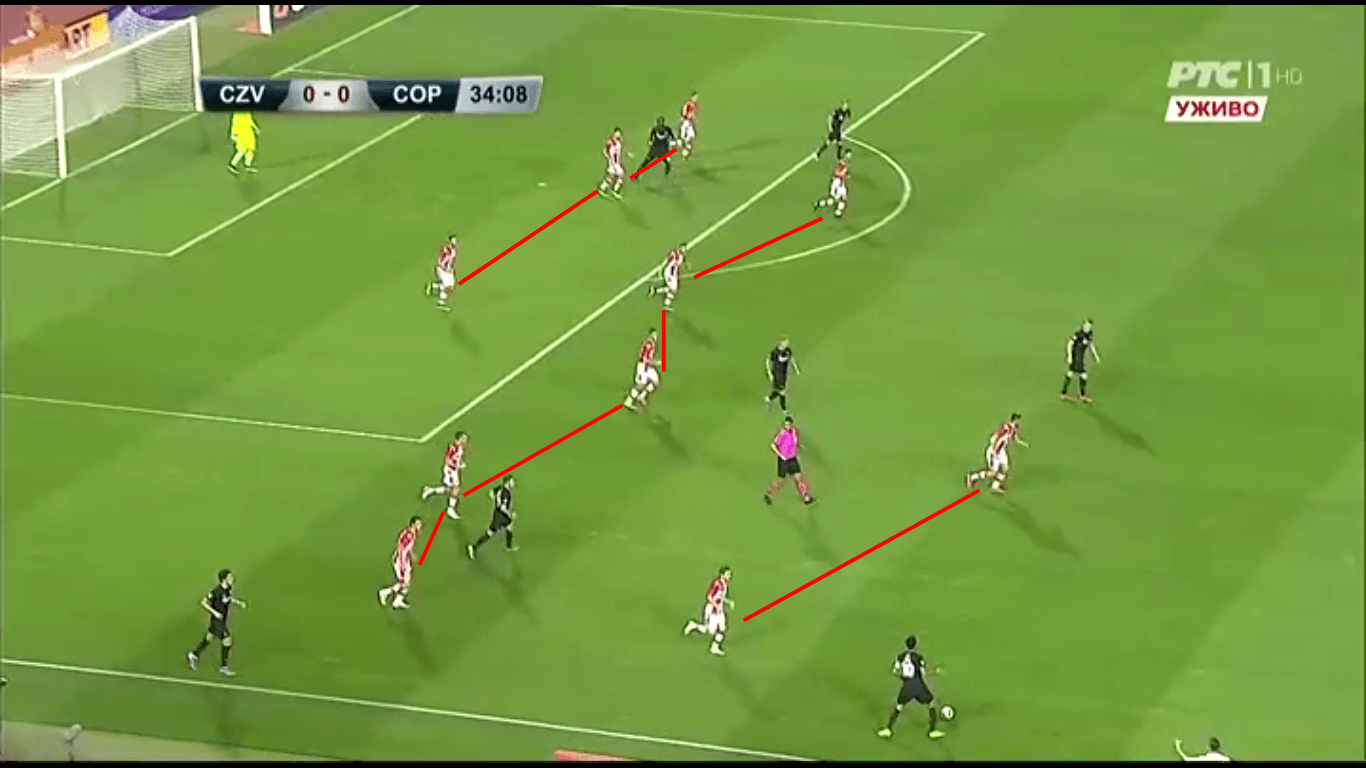
As we can see, the home team had a tendency to transform their defensive tactics and go from 4-4-2 into the 3-5-2 with a great concentration of players on very small parts of the pitch. This helped them to be very close to the most dangerous opposition players and enabled them to protect their goal in much easier fashion.
They also looked to press their opponents right after they lost the ball, providing very good support between each other. Centre-backs of the team were tracking the actions very well and were always there to help their midfielders to win back the possession.
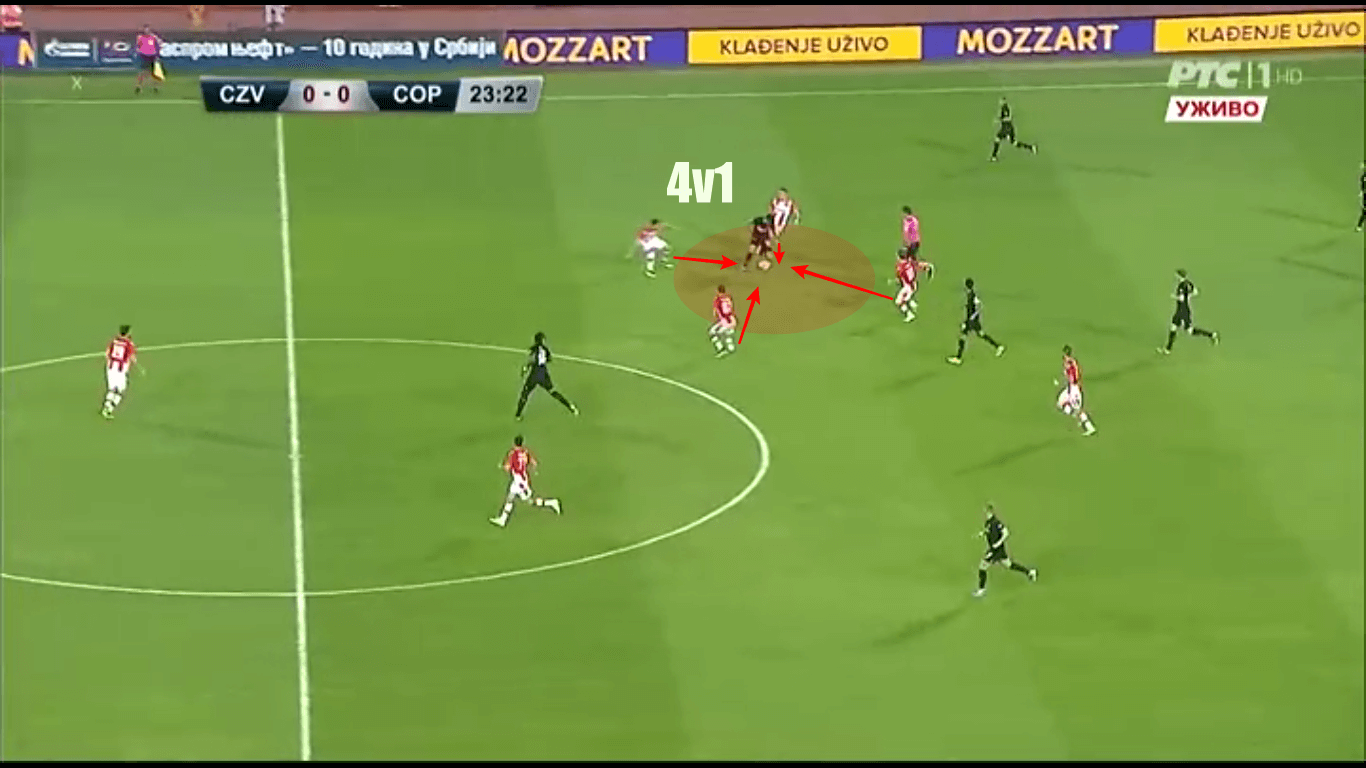
The structure of Milojević’s team was a vital component in contorlling the game for Red Star. Although they didn’t win, Copenhagen didn’t have legs to stand in the biggest part of the 90 minutes and were not creating any opportunities that would threaten the hosts.
The home team’s attacking ideas
The Serbian champions kept defensive structure as their priority but they showed a clear attacking ideology for the first time since the new season began. They played a very tactically offensive game relying mostly on long balls and good attacking movements.
The key idea for Red Star was to keep the the opponent’s defence as narrow as possible – to make them guard their attackers in the tight central areas – and to overlap their full-backs who attempted a lot of crosses throughout the game.
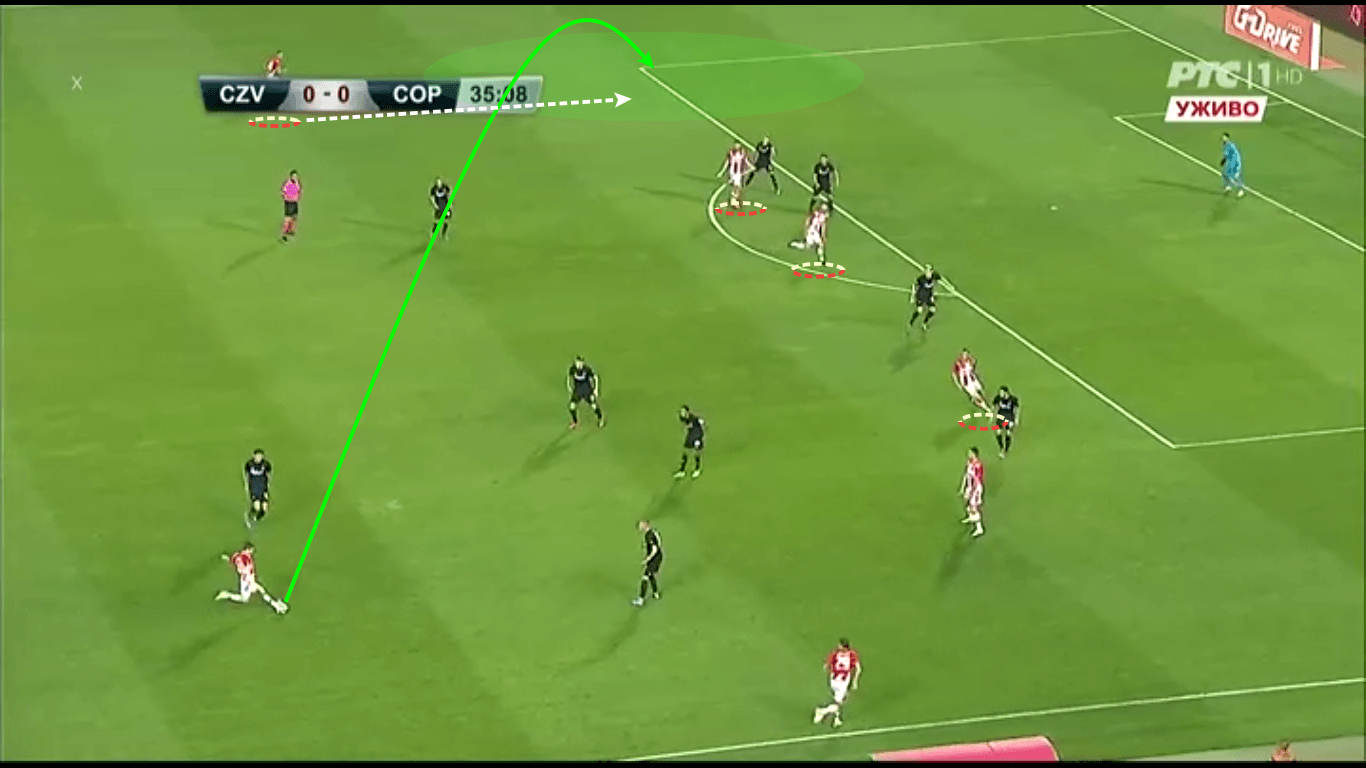
In the image, we can spot how wingers of Milojević’s team positioned themselves in so they could secure a pass for Miloš Rodić on the left flank and Marko Gobeljić on the right-handed side. Mirko Ivanić and Aleksa Vukanović were practically playing as inside forward in order to get opposition’s focus on them which enabled midfielders to send balls to free spaces next to the sidelines for the defenders who ran into them.
They set up in the same way for either one of the full-backs, so Zvezda threatened from the right-handed side as much as from the left one. The full-back of Copenhagen were occupied by the home team wingers and were often at least one step too late to close the pass to the flanks.
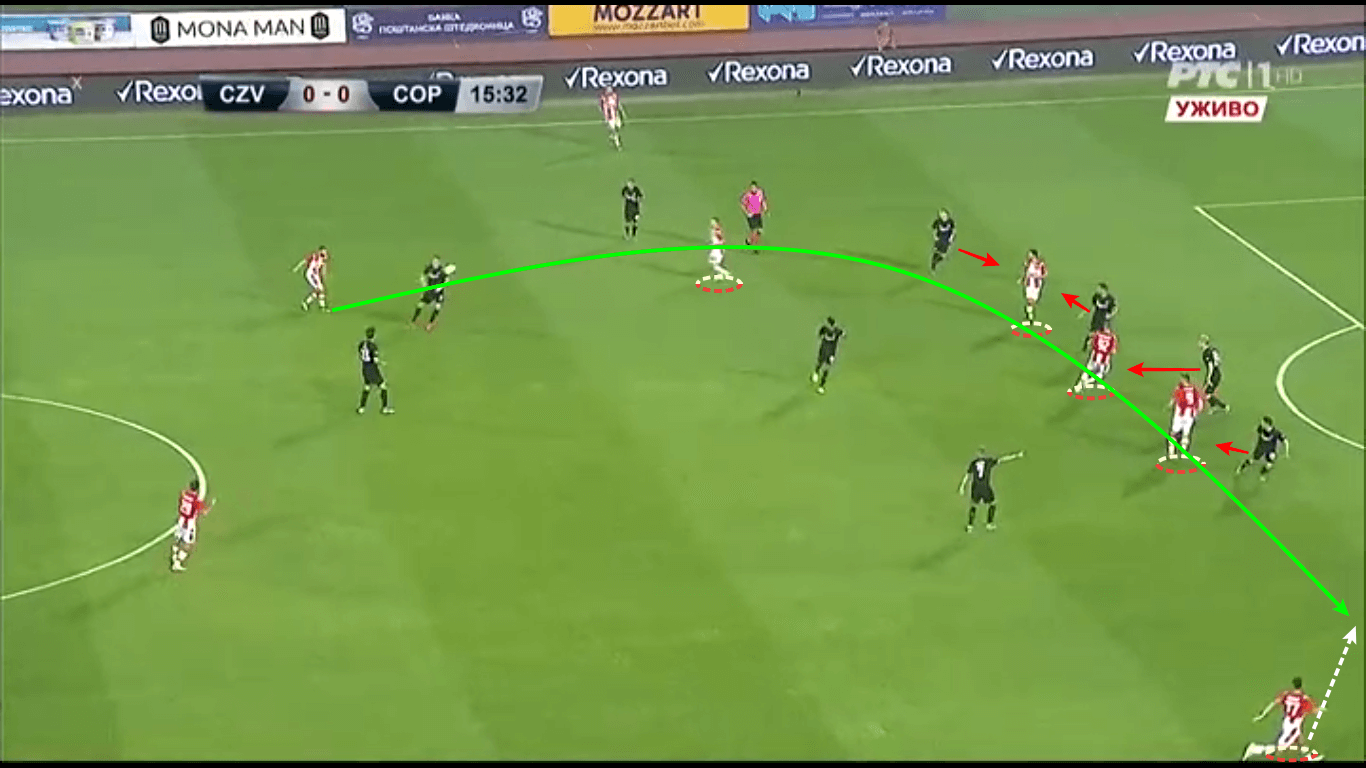
The Serbs used those scenarios to fill the box with their players and wait for the crosses. They had a superiority in the air and also tried to often go in with as many as four of their men, who got to the ball in more than half of those situations which led them into the chances.
Also, the hosts tended to play it with the long balls addressed to their target-man Pavkov, since is very good in the air and has won a lot of duels of this kind against his direct guards. The striker had great support from his offensive team-mates who were always near the action and providing him with a return-pass option in almost every similar setup.
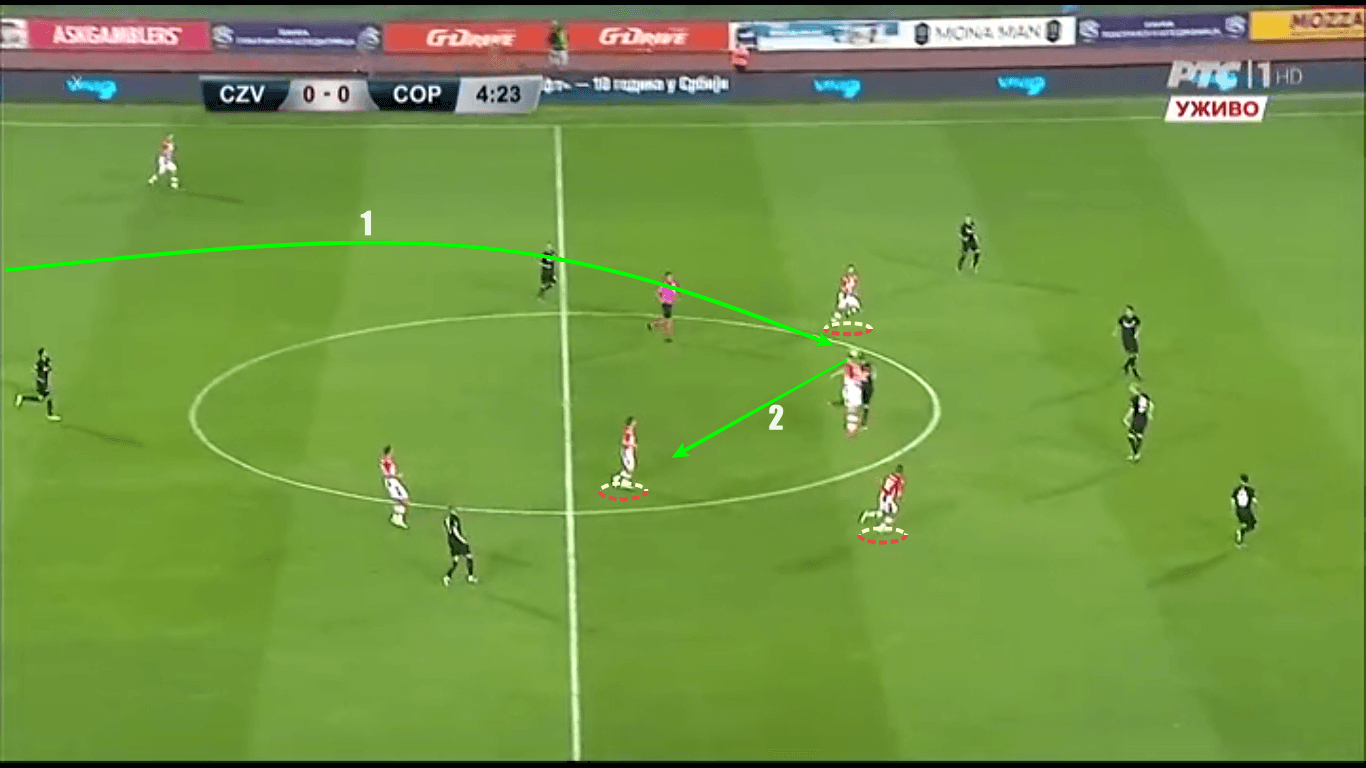
Marin, Ivanić and Vukanović were tracking the game pretty well and often got to the second balls after the long ones were sent to their single forward. Those situations frequently took place when the home team tried to break the opposition’s press and to go on into transitional attack.
They were the most dangerous out of those transformations and counter-attacks, but they also got to their chances through the good communication between the second-line forwards – Marin and Ivanić. The two of them rotated their positions time and again and confused the defenders of the Danish team, mostly because of the motions the German did in the final third.
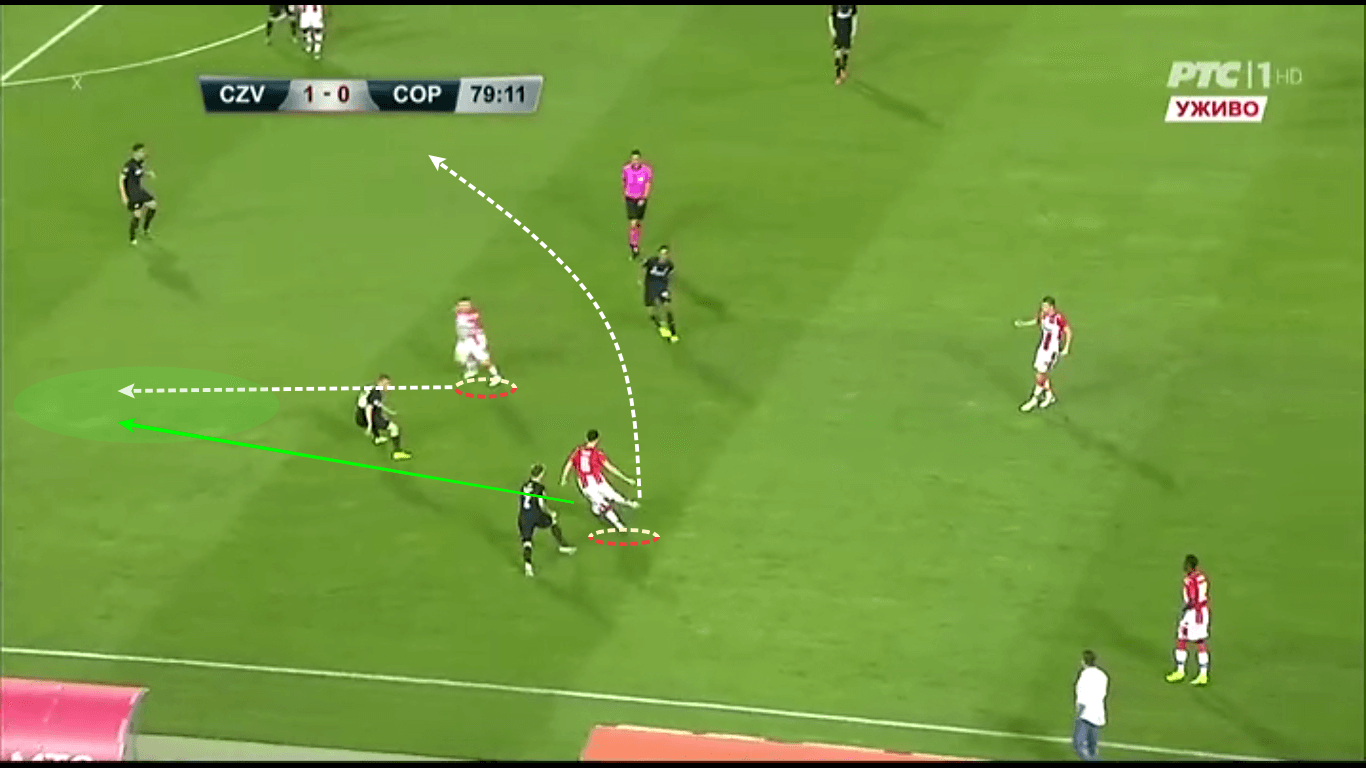
As it is shown on the picture, Red Star’s captain tended to run in behind Copenhagen’s defensive line to exploit the space that was left in behind. When he pulled himself in those areas that were close to the flanks, Ivanić went inside and filled the box along with Pavkov and other team-mates.
Excluding Copenhagen’s strikers and creative players out of the game
The away team struggled to find the way through Zvezda’s block which led their key players to find the way out of those unenviable positions. They needed to drop lower if they wanted to get the ball and start on with an attack, but were always followed by the defenders of Milojević’s team.
N’Doye, who was the most mobile player in Solbakken’s lineup, couldn’t get into chances if he sat tight as a target-man so he came closer to his midfielders in order to help them pass through Red Star’s structure. Miloš Degenek and Nemanja Milunović did a great job disabling him to provide support to his team-mates being all the time by his back and guarding him pretty tight.
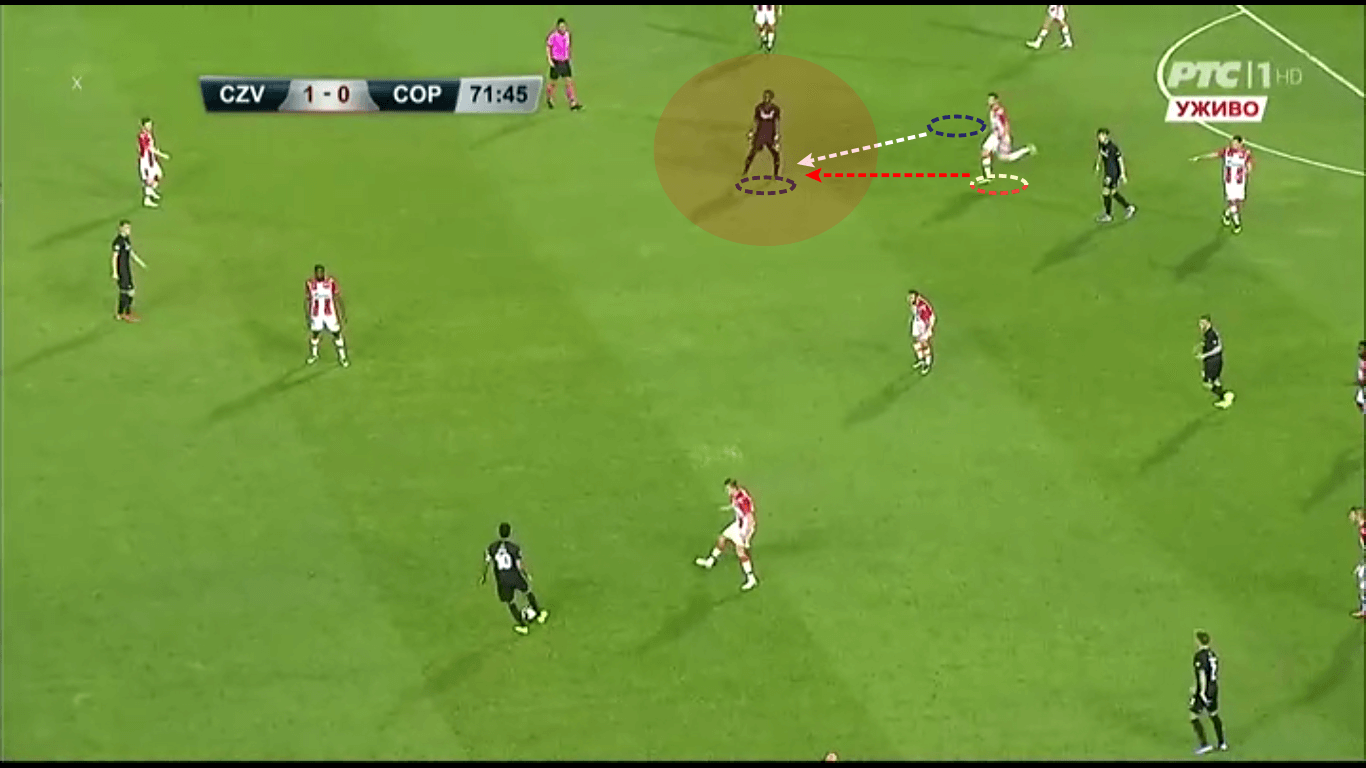
He didn’t have space for manoeuvre so he was cut off in most parts of the match. Even if he dropped even lower and played as a midfielder, the host’s midfield players took care of him and helped their defensive line, which relied on good communication between them.
Also, well-drilled movements in the front lines of the Serbians’ defensive block enabled them to make it pretty difficult for Copenhagen’s midfielders to organise dangerous attacks. They were always very close to them with a tendency to create a numerical superiority over their opponents.
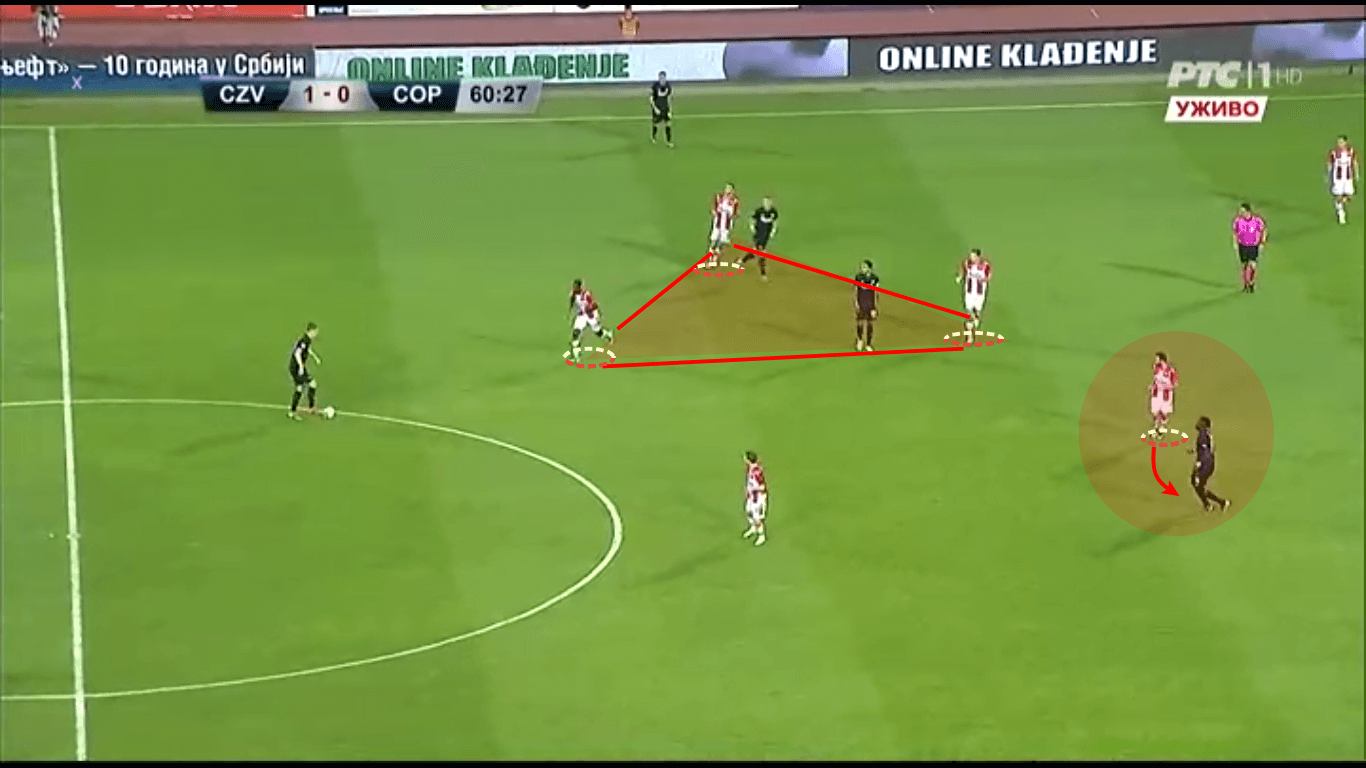
Milojević’s men won back possession a lot of times out of this structure, cutting down the passing lanes to the strikers of the away team and pressing on the midfielders when they were in surplus.
Conclusion
Even though they didn’t win the match, Red Star was the better rival in the first leg and they had control of the situation on the field, which was clearly shown in the analysis. On the other hand, Copenhagen struggled to find the gaps in the well-organised defensive structure of their opponents but managed to score from a penalty, which got them to be luckier with the final result.
The Danes will go into the rematch with an away-goal advantage and will probably try to be more direct at their stadium, but Serbian champions still have their chances, especially if they play it in the same manner as they did in Belgrade.
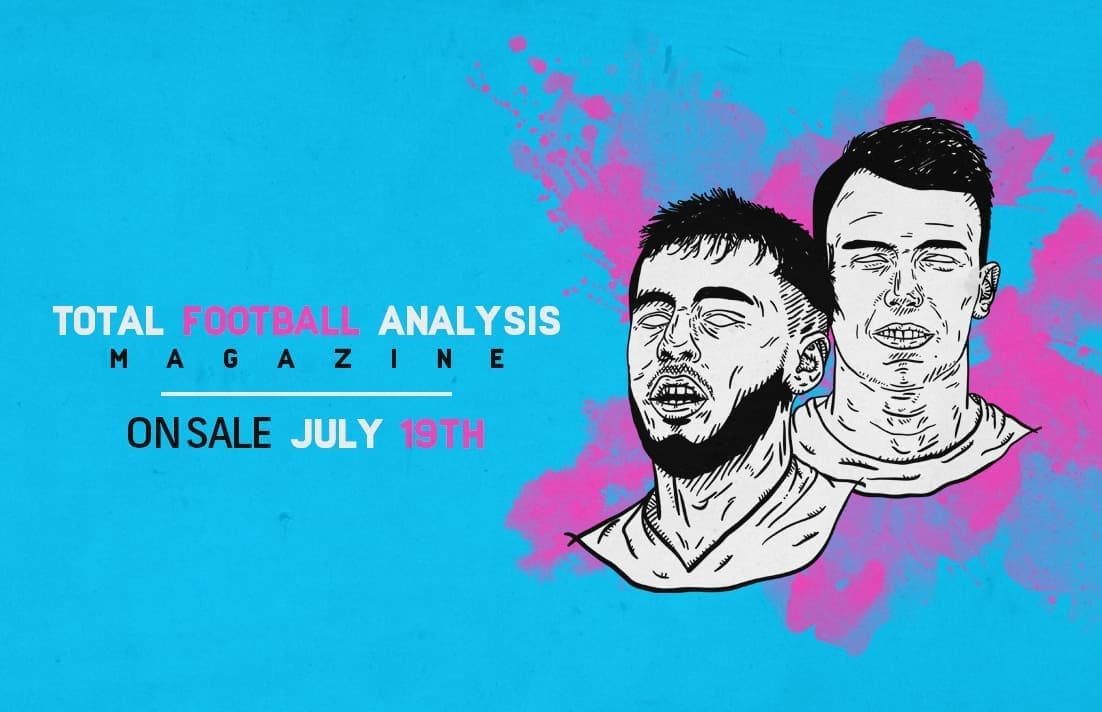
If you love tactical analysis, then you’ll love the digital magazines from totalfootballanalysis.com – a guaranteed 100+ pages of pure tactical analysis covering topics from the Premier League, Serie A, La Liga, Bundesliga and many, many more. Buy your copy of the July issue for just ₤4.99 here, or even better sign up for a ₤50 annual membership (12 monthly issues plus the annual review) right here.

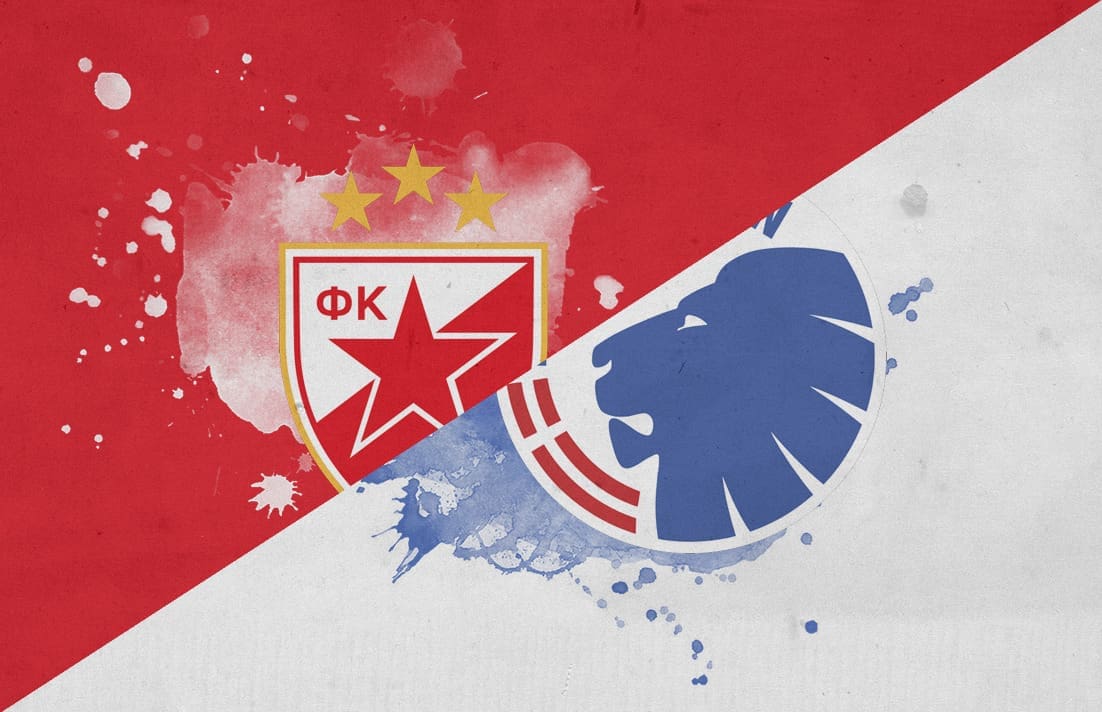



Comments